Trinh Van Chien
Vehicle Routing Problems via Quantum Graph Attention Network Deep Reinforcement Learning
Nov 19, 2025Abstract:The vehicle routing problem (VRP) is a fundamental NP-hard task in intelligent transportation systems with broad applications in logistics and distribution. Deep reinforcement learning (DRL) with Graph Neural Networks (GNNs) has shown promise, yet classical models rely on large multi-layer perceptrons (MLPs) that are parameter-heavy and memory-bound. We propose a Quantum Graph Attention Network (Q-GAT) within a DRL framework, where parameterized quantum circuits (PQCs) replace conventional MLPs at critical readout stages. The hybrid model maintains the expressive capacity of graph attention encoders while reducing trainable parameters by more than 50%. Using proximal policy optimization (PPO) with greedy and stochastic decoding, experiments on VRP benchmarks show that Q-GAT achieves faster convergence and reduces routing cost by about 5% compared with classical GAT baselines. These results demonstrate the potential of PQC-enhanced GNNs as compact and effective solvers for large-scale routing and logistics optimization.
Hybrid Quantum Convolutional Neural Network-Aided Pilot Assignment in Cell-Free Massive MIMO Systems
Jul 09, 2025Abstract:A sophisticated hybrid quantum convolutional neural network (HQCNN) is conceived for handling the pilot assignment task in cell-free massive MIMO systems, while maximizing the total ergodic sum throughput. The existing model-based solutions found in the literature are inefficient and/or computationally demanding. Similarly, conventional deep neural networks may struggle in the face of high-dimensional inputs, require complex architectures, and their convergence is slow due to training numerous hyperparameters. The proposed HQCNN leverages parameterized quantum circuits (PQCs) relying on superposition for enhanced feature extraction. Specifically, we exploit the same PQC across all the convolutional layers for customizing the neural network and for accelerating the convergence. Our numerical results demonstrate that the proposed HQCNN offers a total network throughput close to that of the excessive-complexity exhaustive search and outperforms the state-of-the-art benchmarks.
Quantum Annealing-Based Sum Rate Maximization for Multi-UAV-Aided Wireless Networks
Feb 25, 2025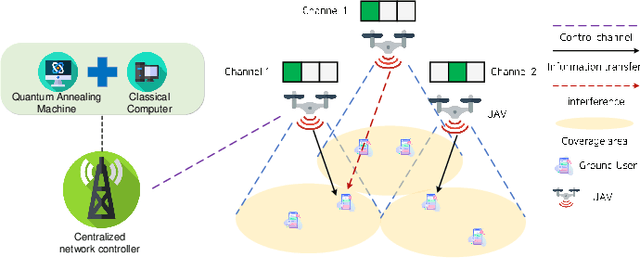
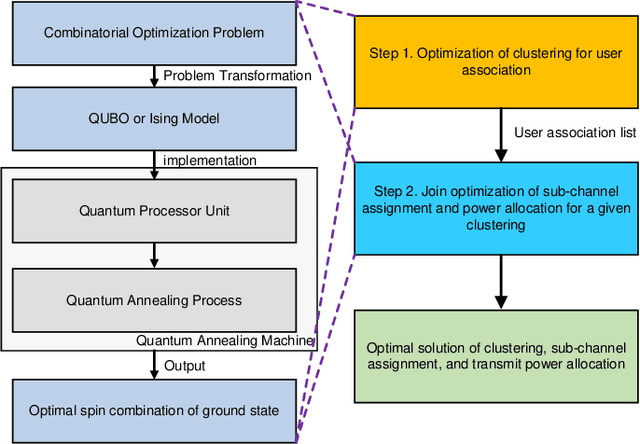
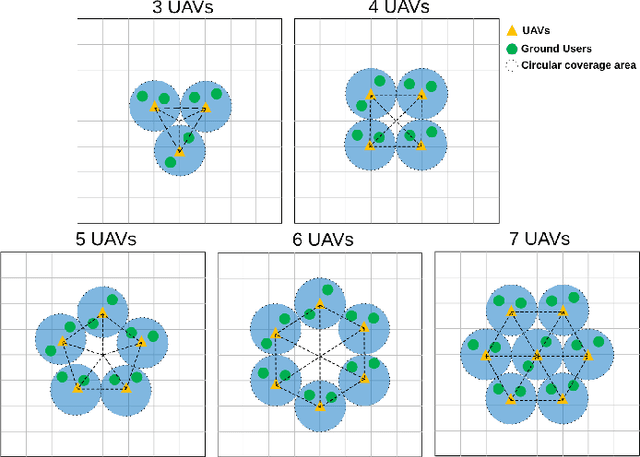
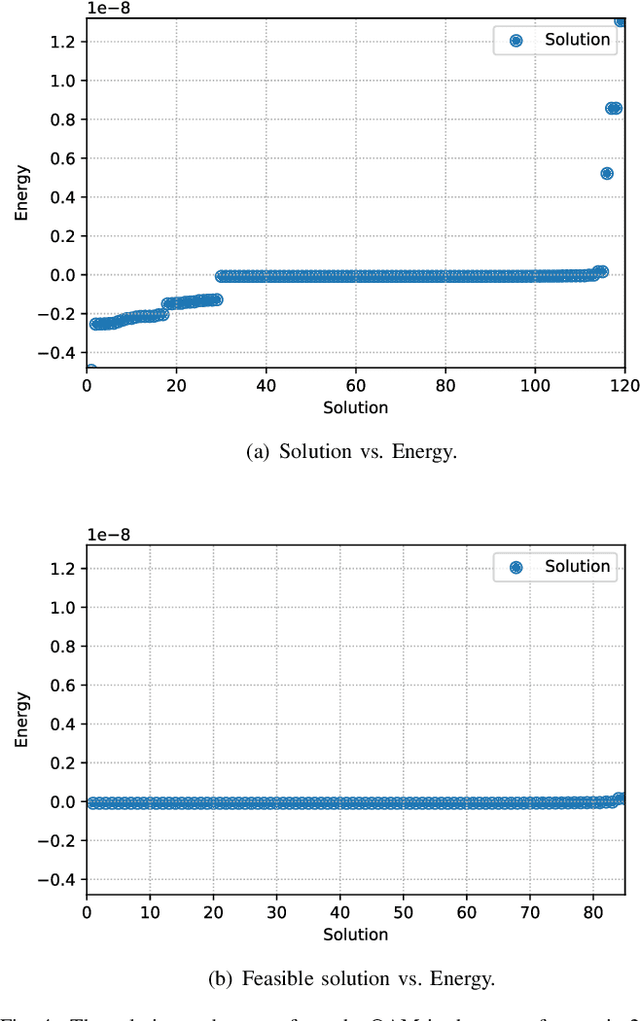
Abstract:In wireless communication networks, it is difficult to solve many NP-hard problems owing to computational complexity and high cost. Recently, quantum annealing (QA) based on quantum physics was introduced as a key enabler for solving optimization problems quickly. However, only some studies consider quantum-based approaches in wireless communications. Therefore, we investigate the performance of a QA solution to an optimization problem in wireless networks. Specifically, we aim to maximize the sum rate by jointly optimizing clustering, sub-channel assignment, and power allocation in a multi-unmanned aerial vehicle-aided wireless network. We formulate the sum rate maximization problem as a combinatorial optimization problem. Then, we divide it into two sub-problems: 1) a QA-based clustering and 2) sub-channel assignment and power allocation for a given clustering configuration. Subsequently, we obtain an optimized solution for the joint optimization problem by solving these two sub-problems. For the first sub-problem, we convert the problem into a simplified quadratic unconstrained binary optimization (QUBO) model. As for the second sub-problem, we introduce a novel QA algorithm with optimal scaling parameters to address it. Simulation results demonstrate the effectiveness of the proposed algorithm in terms of the sum rate and running time.
Active and Passive Beamforming Designs for SER Minimization in RIS-Assisted MIMO Systems
Oct 08, 2024Abstract:This research exploits the applications of reconfigurable intelligent surface (RIS)-assisted multiple input multiple output (MIMO) systems, specifically addressing the enhancement of communication reliability with modulated signals. Specifically, we first derive the analytical downlink symbol error rate (SER) of each user as a multivariate function of both the phase-shift and beamforming vectors. The analytical SER enables us to obtain insights into the synergistic dynamics between the RIS and MIMO communication. We then introduce a novel average SER minimization problem subject to the practical constraints of the transmitted power budget and phase shift coefficients, which is NP-hard. By incorporating the differential evolution (DE) algorithm as a pivotal tool for optimizing the intricate active and passive beamforming variables in RIS-assisted communication systems, the non-convexity of the considered SER optimization problem can be effectively handled. Furthermore, an efficient local search is incorporated into the DE algorithm to overcome the local optimum, and hence offer low SER and high communication reliability. Monte Carlo simulations validate the analytical results and the proposed optimization framework, indicating that the joint active and passive beamforming design is superior to the other benchmarks.
RIS-Assisted Cell-Free Massive MIMO Relying on Reflection Pattern Modulation
Aug 10, 2024Abstract:We propose reflection pattern modulation-aided reconfigurable intelligent surface (RPM-RIS)-assisted cell-free massive multiple-input-multiple-output (CF-mMIMO) schemes for green uplink transmission. In our RPM-RIS-assisted CF-mMIMO system, extra information is conveyed by the indices of the active RIS blocks, exploiting the joint benefits of both RIS-assisted CF-mMIMO transmission and RPM. Since only part of the RIS blocks are active, our proposed architecture strikes a flexible energy \emph{vs.} spectral efficiency (SE) trade-off. We commence with introducing the system model by considering spatially correlated channels. Moreover, we conceive a channel estimation scheme subject to the linear minimum mean-square error (MMSE) constraint, yielding sufficient information for the subsequent signal processing steps. Then, upon exploiting a so-called large-scale fading decoding (LSFD) scheme, the uplink signal-to-interference-and-noise ratio (SINR) is derived based on the RIS ON/OFF statistics, where both maximum ratio (MR) and local minimum mean-square error (L-MMSE) combiners are considered. By invoking the MR combiner, the closed-form expression of the uplink SE is formulated based only on the channel statistics. Furthermore, we derive the total energy efficiency (EE) of our proposed RPM-RIS-assisted CF-mMIMO system. Additionally, we propose a chaotic sequence-based adaptive particle swarm optimization (CSA-PSO) algorithm to maximize the total EE by designing the RIS phase shifts. Finally, our simulation results demonstrate that the proposed RPM-RIS-assisted CF-mMIMO architecture strikes an attractive SE \emph{vs.} EE trade-off, while the CSA-PSO algorithm is capable of attaining a significant EE performance gain compared to conventional solutions.
Graph Neural Network based Active and Passive Beamforming for Distributed STAR-RIS-Assisted Multi-User MISO Systems
May 03, 2024
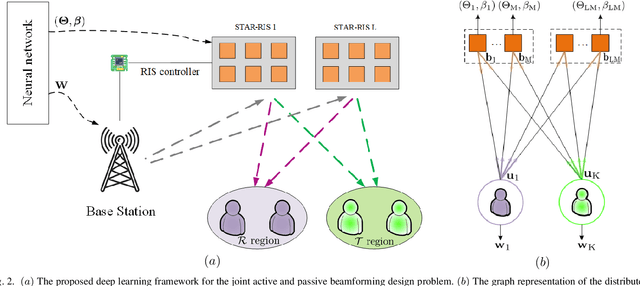
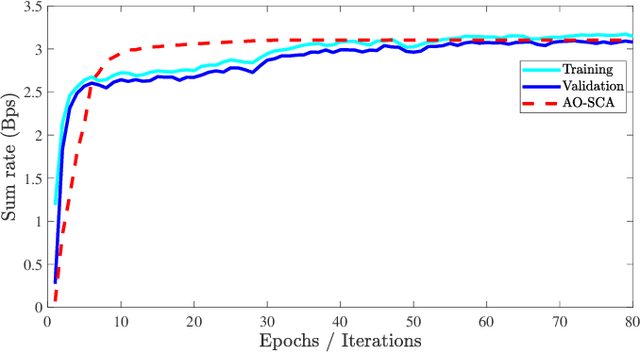
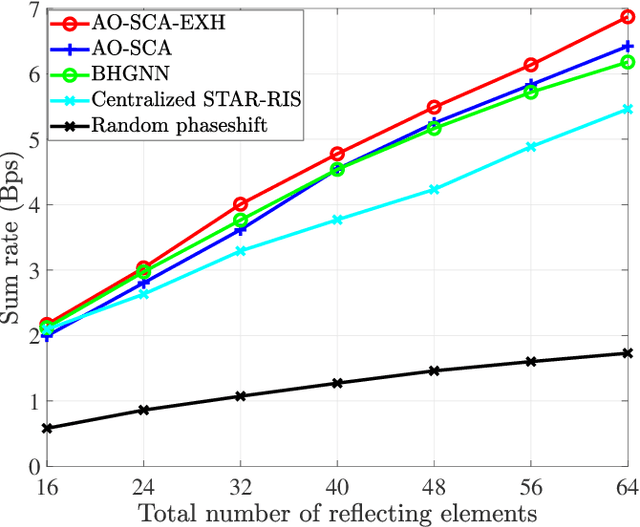
Abstract:This paper investigates a joint active and passive beamforming design for distributed simultaneous transmitting and reflecting (STAR) reconfigurable intelligent surface (RIS) assisted multi-user (MU)- mutiple input single output (MISO) systems, where the energy splitting (ES) mode is considered for the STAR-RIS. We aim to design the active beamforming vectors at the base station (BS) and the passive beamforming at the STAR-RIS to maximize the user sum rate under transmitting power constraints. The formulated problem is non-convex and nontrivial to obtain the global optimum due to the coupling between active beamforming vectors and STAR-RIS phase shifts. To efficiently solve the problem, we propose a novel graph neural network (GNN)-based framework. Specifically, we first model the interactions among users and network entities are using a heterogeneous graph representation. A heterogeneous graph neural network (HGNN) implementation is then introduced to directly optimizes beamforming vectors and STAR-RIS coefficients with the system objective. Numerical results show that the proposed approach yields efficient performance compared to the previous benchmarks. Furthermore, the proposed GNN is scalable with various system configurations.
Joint Power Allocation and User Scheduling in Integrated Satellite-Terrestrial Cell-Free Massive MIMO IoT Systems
Jan 08, 2024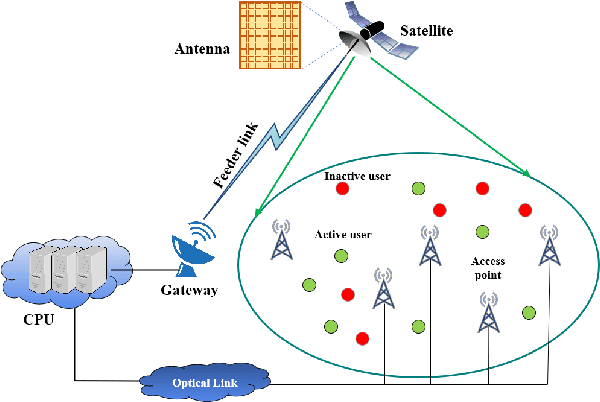
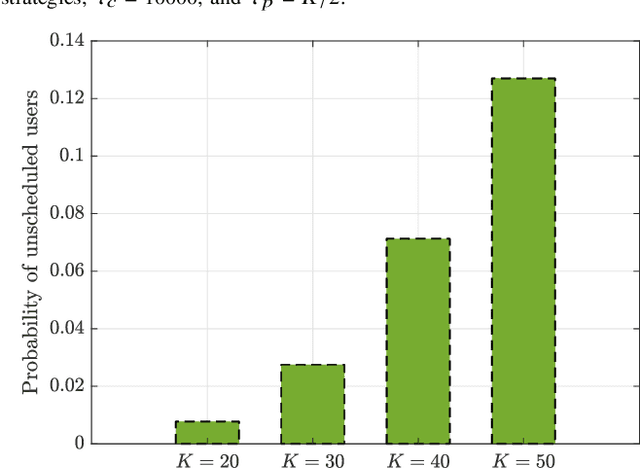
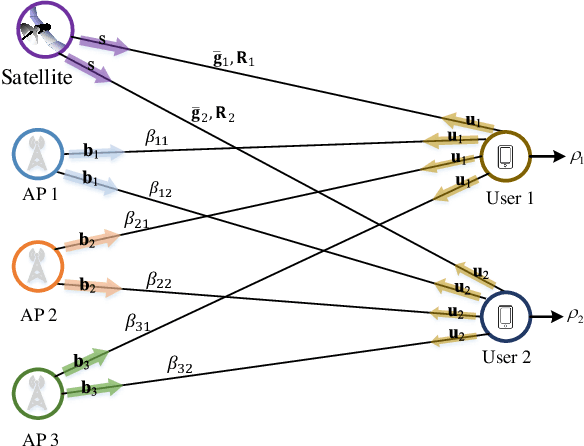
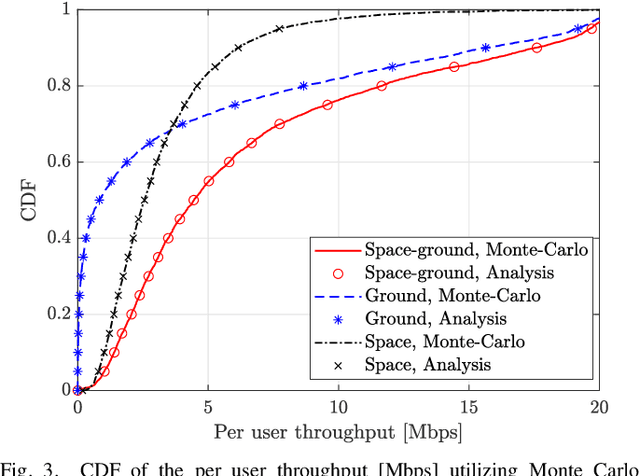
Abstract:Both space and ground communications have been proven effective solutions under different perspectives in Internet of Things (IoT) networks. This paper investigates multiple-access scenarios, where plenty of IoT users are cooperatively served by a satellite in space and access points (APs) on the ground. Available users in each coherence interval are split into scheduled and unscheduled subsets to optimize limited radio resources. We compute the uplink ergodic throughput of each scheduled user under imperfect channel state information (CSI) and non-orthogonal pilot signals. As maximum-radio combining is deployed locally at the ground gateway and the APs, the uplink ergodic throughput is obtained in a closed-form expression. The analytical results explicitly unveil the effects of channel conditions and pilot contamination on each scheduled user. By maximizing the sum throughput, the system can simultaneously determine scheduled users and perform power allocation based on either a model-based approach with alternating optimization or a learning-based approach with the graph neural network. Numerical results manifest that integrated satellite-terrestrial cell-free massive multiple-input multiple-output systems can significantly improve the sum ergodic throughput over coherence intervals. The integrated systems can schedule the vast majority of users; some might be out of service due to the limited power budget.
Double RIS-Assisted MIMO Systems Over Spatially Correlated Rician Fading Channels and Finite Scatterers
Sep 08, 2023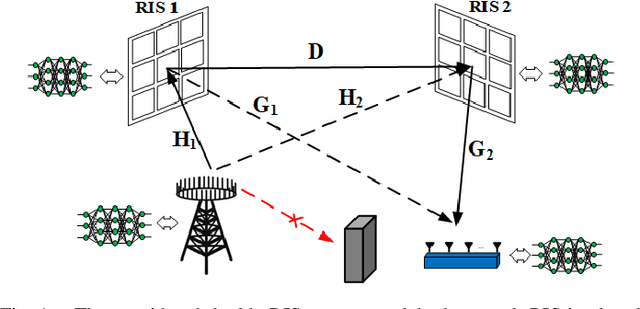
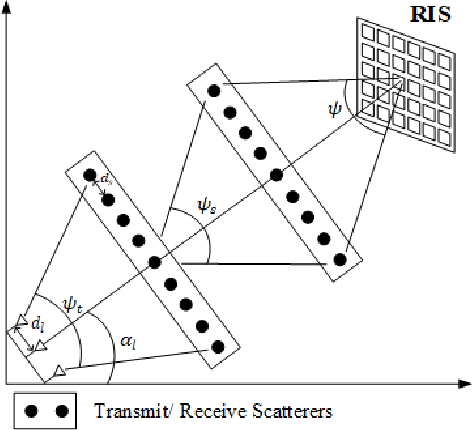

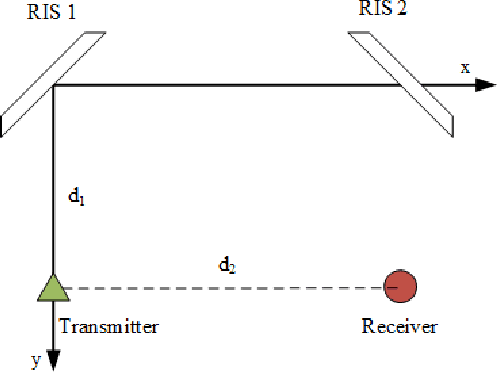
Abstract:This paper investigates double RIS-assisted MIMO communication systems over Rician fading channels with finite scatterers, spatial correlation, and the existence of a double-scattering link between the transceiver. First, the statistical information is driven in closed form for the aggregated channels, unveiling various influences of the system and environment on the average channel power gains. Next, we study two active and passive beamforming designs corresponding to two objectives. The first problem maximizes channel capacity by jointly optimizing the active precoding and combining matrices at the transceivers and passive beamforming at the double RISs subject to the transmitting power constraint. In order to tackle the inherently non-convex issue, we propose an efficient alternating optimization algorithm (AO) based on the alternating direction method of multipliers (ADMM). The second problem enhances communication reliability by jointly training the encoder and decoder at the transceivers and the phase shifters at the RISs. Each neural network representing a system entity in an end-to-end learning framework is proposed to minimize the symbol error rate of the detected symbols by controlling the transceiver and the RISs phase shifts. Numerical results verify our analysis and demonstrate the superior improvements of phase shift designs to boost system performance.
RIS-Assisted Wireless Communications: Long-Term versus Short-Term Phase Shift Designs
Sep 07, 2023Abstract:Reconfigurable intelligent surface (RIS) has recently gained significant interest as an emerging technology for future wireless networks thanks to its potential for improving the coverage probability in challenging propagation environments. This paper studies an RIS-assisted propagation environment, where a source transmits data to a destination in the presence of a weak direct link. We analyze and compare RIS designs based on long-term and short-term channel statistics in terms of coverage probability and ergodic rate. For the considered optimization designs, we derive closed-form expressions for the coverage probability and ergodic rate, which explicitly unveil the impact of both the propagation environment and the RIS on the system performance. Besides the optimization of the RIS phase profile, we formulate an RIS placement optimization problem with the aim of maximizing the coverage probability by relying only on partial channel state information. An efficient algorithm is proposed based on the gradient ascent method. Simulation results are illustrated in order to corroborate the analytical framework and findings. The proposed RIS phase profile is shown to outperform several heuristic benchmarks in terms of outage probability and ergodic rate. In addition, the proposed RIS placement strategy provides an extra degree of freedom that remarkably improves system performance.
Phase Shift Design for RIS-Aided Cell-Free Massive MIMO with Improved Differential Evolution
Aug 12, 2023

Abstract:This paper proposes a novel phase shift design for cell-free massive multiple-input and multiple-output (MIMO) systems assisted by reconfigurable intelligent surface (RIS), which only utilizes channel statistics to achieve the uplink sum ergodic throughput maximization under spatial channel correlations. Due to the non-convexity and the scale of the derived optimization problem, we develop an improved version of the differential evolution (DE) algorithm. The proposed scheme is capable of providing high-quality solutions within reasonable computing time. Numerical results demonstrate superior improvements of the proposed phase shift designs over the other benchmarks, particularly in scenarios where direct links are highly probable.
 Add to Chrome
Add to Chrome Add to Firefox
Add to Firefox Add to Edge
Add to Edge